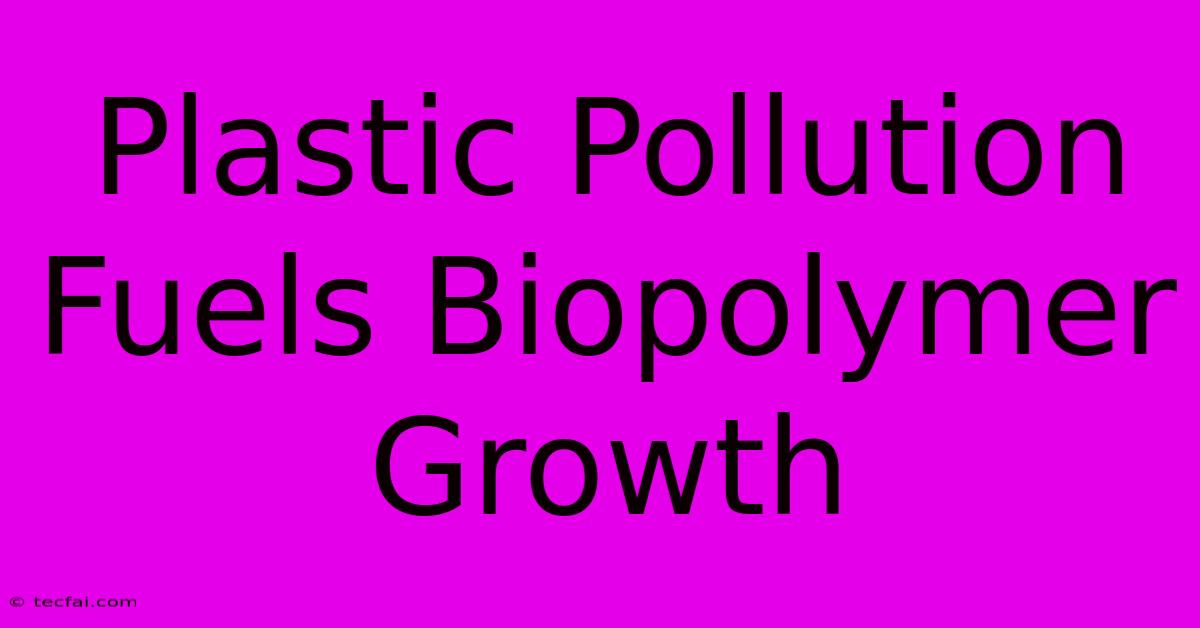Plastic Pollution Fuels Biopolymer Growth

Discover more detailed and exciting information on our website. Click the link below to start your adventure: Visit Best Website tecfai.com. Don't miss out!
Table of Contents
Plastic Pollution Fuels Biopolymer Growth
The world is drowning in plastic. This isn't news; the sheer volume of plastic waste accumulating in landfills, oceans, and even our soil is a global crisis. But this crisis is inadvertently fueling a revolution: the rapid growth of the biopolymer industry. As the negative consequences of traditional petroleum-based plastics become increasingly clear, the demand for sustainable alternatives is exploding, driving innovation and investment in biopolymers.
What are Biopolymers?
Biopolymers are polymers derived from renewable biomass sources, such as plants, microorganisms, or agricultural waste. Unlike conventional plastics made from fossil fuels, biopolymers offer a more environmentally friendly alternative. They are biodegradable, compostable, or at least bio-based, meaning they are partially derived from renewable sources. This significant difference makes them an attractive solution to combatting plastic pollution.
Key Types of Biopolymers:
Several types of biopolymers are currently available or under development, each with its own unique properties and applications:
- Polylactic Acid (PLA): One of the most prevalent biopolymers, PLA is commonly used in food packaging, 3D printing filaments, and disposable cutlery. It's biodegradable under industrial composting conditions.
- Polyhydroxyalkanoates (PHAs): A family of biopolymers known for their versatility and biodegradability in various environments, including soil and seawater. PHAs are finding applications in medical implants, packaging, and agricultural films.
- Starch-based Polymers: Derived from starch extracted from plants like corn or potatoes, these biopolymers are used in disposable bags, films, and coatings. Their biodegradability depends on the specific formulation.
- Cellulose-based Polymers: Cellulose, a major component of plant cell walls, is used to create biopolymers for various applications, including packaging and textiles.
The Driving Force: The Plastic Pollution Problem
The escalating global plastic pollution problem acts as a powerful catalyst for the biopolymer market. The images of plastic-choked oceans and overflowing landfills are galvanizing public opinion, pushing consumers and businesses towards more sustainable alternatives. Governments worldwide are also responding with stricter regulations on plastic use and disposal, further boosting the demand for bio-based solutions.
The Economic Incentive:
Beyond the environmental imperative, there's a strong economic incentive driving biopolymer growth. The increasing cost of petroleum and the rising regulatory pressure on single-use plastics create a favorable market environment for biopolymers. Investors are recognizing the long-term potential of this industry and are pouring significant capital into research, development, and production.
Challenges and Future Prospects
While the future of biopolymers looks bright, several challenges remain. Scaling up production to meet the growing demand is a significant hurdle. Furthermore, some biopolymers can be more expensive than their petroleum-based counterparts, limiting their widespread adoption. Standardization and harmonization of biodegradability testing methods are also crucial for ensuring consumer trust and facilitating market growth.
Looking Ahead:
Despite the challenges, the future of biopolymers appears promising. Ongoing research and development are focusing on improving their performance characteristics, reducing production costs, and expanding their applications. As consumers become more environmentally conscious and governments implement stricter regulations, the biopolymer industry is poised for substantial expansion, playing a vital role in addressing the global plastic pollution crisis and creating a more sustainable future.
Conclusion: A Sustainable Solution
The link between plastic pollution and the growth of the biopolymer industry is undeniable. The urgent need to tackle plastic waste is driving innovation and investment in this exciting field. While challenges remain, the potential for biopolymers to offer a sustainable solution to the global plastic crisis is immense, promising a future where plastic pollution is significantly reduced and replaced by environmentally friendly alternatives. The movement towards a circular economy, fueled by the urgent need to solve plastic pollution, places biopolymers at the forefront of sustainable material innovation.

Thank you for visiting our website wich cover about Plastic Pollution Fuels Biopolymer Growth. We hope the information provided has been useful to you. Feel free to contact us if you have any questions or need further assistance. See you next time and dont miss to bookmark.
Featured Posts
-
Amg National Trust Reduces Axp Stake
Nov 19, 2024
-
High Demand Wolfe Tones Second Limerick Date
Nov 19, 2024
-
Seahorse Sa Paghahanap Ng Kayamanan
Nov 19, 2024
-
Council Evicts Man Over Waste
Nov 19, 2024
-
Likely Showers And Storms Today
Nov 19, 2024
